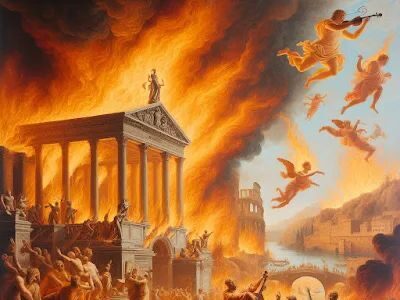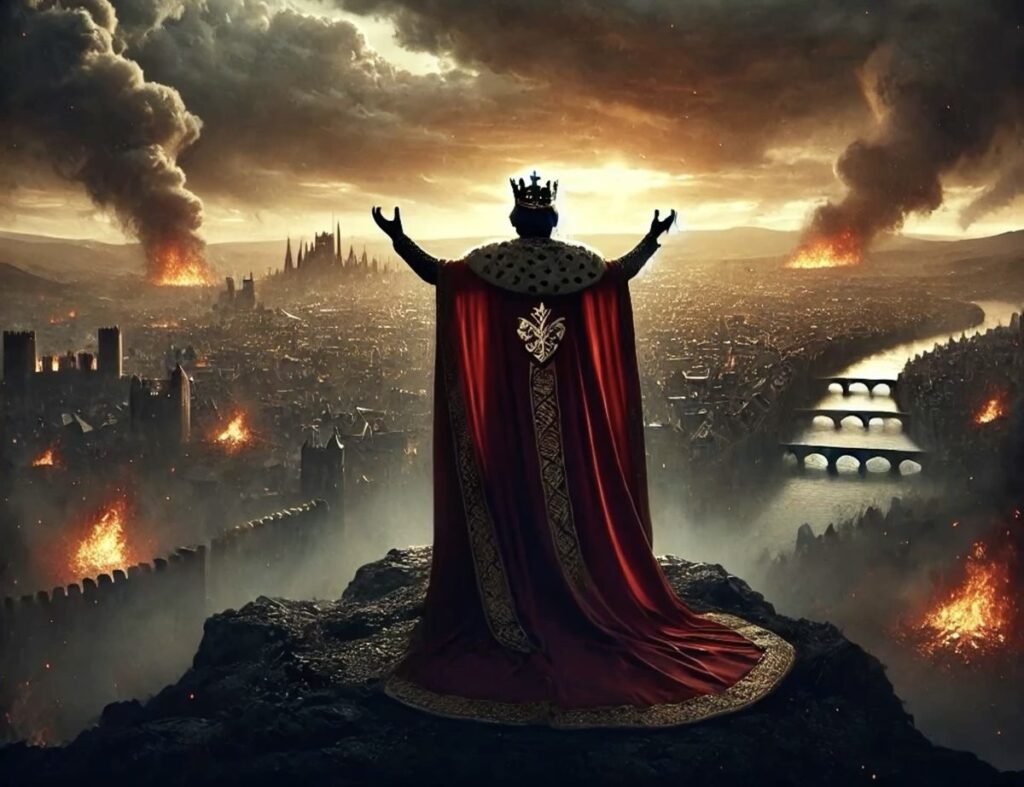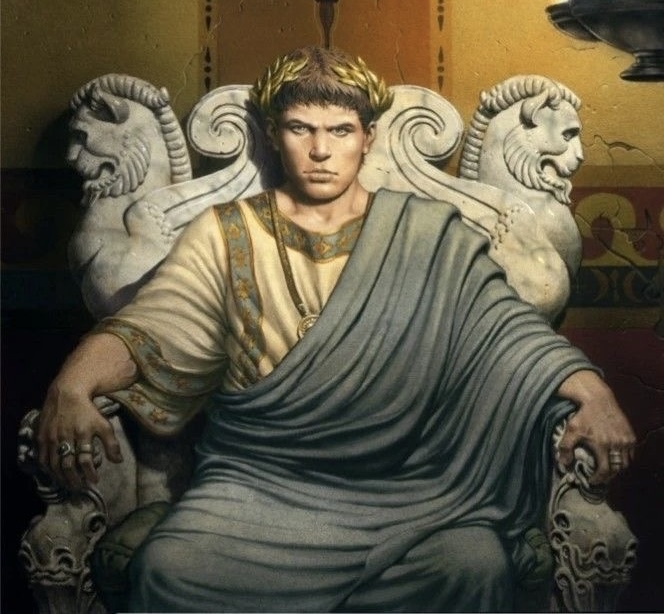Imagine scrolling through your phone and seeing flashy celebrities, extravagant condos, and shocking tweets. It will feel like normal drama, right? But what if I told you that nearly 2000 years ago, Rome had a superstar emperor who had everything?
He had power, fame, luxury, and let’s not forget, a shocking downfall. His name was Nero.
If Instagram existed 2000 years ago, Emperor Nero would have been the ultimate influencer. Just picture a teenage ruler with unlimited money, a taste for gold, wild parties, and a burning sensation for music and drama… literally.
He was famous, flashy, and a total red flag. Nero had everything. He had family drama, scandal, conspiracy, betrayal, and a mysterious fire that almost destroyed Rome.
History does not just repeat; sometimes it goes viral.
However, behind the glitz and glitter was an emperor who cared more about applause than his people. He cared more about building a golden palace than keeping his empire from crumbling.
Sound familiar? Yes, history has a funny way of repeating itself. Back then, it was Nero. Today, we see leaders and celebrities who chase likes, headlines, and attention, while the real problems continue to pile up. History does not just repeat; sometimes it goes viral.
Let’s learn more about the rise and fall of Emperor Nero and see how stories from ancient Rome continue to influence our digital world today.
Meet Nero: The Boy Who Became Emperor
Nero was born December 15, AD 37, as Lucius Domitius Ahenobarbus in Antium, Italy. His mother, Agrippina the Younger, was ambitious and a powerful figure. She married Emperor Claudius and got him to adopt Nero when he was just 11 years old.
When Claudius died in AD 54, Nero became emperor at the tender age of sixteen. At first, he was guided by his mother, the philosopher Seneca, and the Praetorian Prefect Burrus. But soon he wanted full control, and that spelled trouble.
The Great Fire raged for nine days, destroyed 10 to 14 districts, and displaced hundreds of thousands of people.
Nero liked to think of himself as an artist. He performed on stage, played lyre, and wrote poetry, but behind the artsy façade, there was darkness. Nero ordered his own mother, Agrippina, to be killed. He also got rid of his stepbrother, Britanicus, and his first wife, Claudia Octavia.
He allegedly did this solely to marry Poppaea Sabina. Historians such as Tacitus and Suetonius portray him as a cruel person, but modern research suggests that there may have been some exaggeration; they claim that Emperor Nero’s story was shaped by his enemies who came after him.
The Fire That Changed Everything
In July AD 64, Rome was attacked by the Great Fire. The Great Fire raged for nine days. It destroyed 10 to 14 districts and displaced hundreds of thousands of people. After the incident, rumors flew.
People were saying, “Nero fiddled while Rome burned,” even though fiddles did not yet exist at that time. So basically, we do not have proof that he started it, but we do know one thing: he certainly took advantage of the fire.

Nero rushed back from Antium, opened his gardens to the victims, and rebuilt parts of the city with fireproof stones and brick. However, despite his effort, public anger grew; they were angry because he blamed Rome’s Christians and prosecuted them brutally to distract himself.
Scapegoats and Spectacles
After the fire, Emperor Nero needed someone to blame, and after thinking long and hard, he used Christians as the scapegoat. They were foreign, they believed in only one God, and they refused Roman religion. All of these made them perfect targets.
He unleashed brutal executions on Christians, including crucifixions, burning them alive, and wild beast attacks.
Nero accused the Christians of arson and to punish them, he unleashed brutal executions, including crucifixions, burning them alive, and wild beast attacks. He often carried out these punishments in public shows to entertain people.
This tactic was common in ancient times. They referred to it as the “divide and conquer strategy.” It is like blaming a minority in order to unite others.
Today, this strategy echoes in our digital world. Politicians blame groups, social media amplifies outrage, and distraction masks larger faults.
The Golden Palace: Domus Aurea
The greatest vanity project that Nero built was the Domus Aurea, “his golden house,” which he constructed immediately after the Great Fire. This palace stretched across more than 100 acres in the heart of Rome. It had marble walls, gold, leaf, frescoes, fountains, artificial lakes, and even vineyards. It was basically a “countryside in the city.”

Inside the palace, a banquet hall featured a revolving ceiling. This ceiling was powered by water, and it often showered guests with flower petals, scents, and perfume. The whole thing was a technical marvel.
Nero also had a massive bronze statue of himself, a 120-foot-tall statue that was placed near the entrance. The palace symbolized absolute power… and absolute waste.
The worst part is, he hardly lived there. The palace was meant for spectacle and propaganda, not daily life. It was his version of “influencer drip,” except without the influencer.
The Backlash: When Celebrity Culture Turns Sour
At first, the public had been charmed by Nero’s artistic flair— the music, the performance, and the charm. But when his glittering palace was erected, the bill for all that gold had to land somewhere.
Yes, you guessed it… It landed on the people. The tax authorities had to pay significantly increased taxes, and what started as admiration began to turn sour, setting in motion a chain of problems.
Modern scholars are now suggesting that much of what we think we know about Nero is based on manipulation and lies that date back 2,000 years.
Inflation started, provinces were squeezed, people faced hardship, and tension rose. Critics pointed to Domus Aurea as proof of Nero’s megalomania; the emperor who cared more about selfies than stability.
Soon, governors in Hispania and Gaul revolted with the support of the Senate. By June 9, AD 68, Nero was declared a public enemy. Facing death, he fled and committed suicide. His final words were “What an artist dies in me!” He was just 30 years old.
With his death, the Julio-Claudian dynasty came to an end. The Golden Palace was buried/dismantled, many of its mosaics and decorations were looted, and the Colosseum was built over its artificial lake.
History’s Memory: Nero’s Lasting Shadow
The official version of Nero being a cruel tyrant was shaped by historians who came after him. These historians include Suetonius, Tacitus, and Cassius Dio. The narratives may be biased, as they were written by Nero’s enemies, who had a motive to tarnish his name. Modern scholars are now suggesting that much of what we think we know about Nero is based on manipulation and lies that date back 2,000 years.
Regardless, Nero remains a cultural shorthand; his name still brings a certain idea or image to people’s minds. He shows up in songs, TV shows, books, and memes. He is the symbol of living in extreme luxury and how having too much power can completely ruin a person.
Nero and Ancient Rome Meet Digital Distraction
Now, fast-forward to the world of smartphones, social media, 24/7 celebrity news, and political outrage. What does the fall of Nero and ancient Rome teach us?

Distraction as Control
Nero entertained the masses with gladiators, banquets, and scapegoats. Today, politicians distract citizens with viral videos, conspiracy theories, celebrity gossip, and outrage culture. It is easier to control public sentiment when it is entertained and divided.
The Roman Empire did not just fall due to foreign invasion, it suffered internal stress, inflation, civil war, and political chaos.
Celebrity Culture Gets Toxic
Like Nero, modern figures who become famous sometimes collapse under scandal. How they spend money, the parties they throw or attend, the title might look good at first, until the headline turns. It is the same arc: build image, demand adoration, and ignore governance.
Collapse Requires Imbalance
The Roman Empire did not simply fall due to foreign invasion; it also suffered from internal stress, inflation, civil war, and political chaos. Digital empires, that is, nations/states, as well as democracies, can sense when trust fades away and attention is diverted by spectacle.
When people stop trusting their leaders or the system, they begin to listen to those who share their views. Leaders who focus on keeping people entertained instead of addressing the real problems slowly destroy a country from within.
Bread and Circuses Then, Breadsticks and Streaming Now
Roman leaders were famous for keeping citizens happy with food and entertainment, namely bread and circuses, in order to avoid addressing deeper issues. Now we have streaming shows, infinite scrolling, food delivery apps, and political leaders who heavily rely on digital platforms to pacify their populations.

Lessons from Nero’s Rise and Fall
Let’s break it down. Nero wanted to be an artistic king, and that was fine, but he neglected his responsibilities. He had too many on-stage solos going on, but not enough governing. He had ambition without balance.
While the city struggled to recover, Nero worked to make the gap between the powerful and the powerless impossible to ignore.
Nero used a group of people as scapegoats, and this harmed unity. He didn’t just point fingers, he aimed them. By blaming Christians, he took the spotlight off himself, but in doing so, he tore open wounds in Rome that would never fully heal. It is the same trick we see online today, where blaming certain groups fuels mistrust and division.
While the city struggled to recover, Nero poured money into his own luxuries, making the gap between the powerful and the powerless impossible to ignore.
Another thing to consider is that what we know about Nero comes from the people who succeeded him after his death, so their version of the story may be biased. Similarly, the stories we know today are influenced by social media, news, and individuals with their own agendas.
Ironically, Nero initially did some good things. He made some helpful changes, lowered taxes, and was initially popular and well-liked by the people. However, his story shows that even a leader who begins with good intentions can lose it all if they abuse their power.
The Domino Effect: Empire Collapse and Echoes Today
The Roman Empire did not fall overnight, it staggered for centuries. But Nero’s time as emperor was one of the first big cracks. When he died in AD 68, chaos broke out. Rome had four different emperors in one year, and there were civil wars; eventually, a new family, the Flavians, took over. This constant drama weakened Rome, and centuries later, in AD 476, the Western Empire finally fell.
Today, countries can survive tough times, but if leaders prioritize putting on a show over addressing problems and continue to distract people instead of making informed decisions, our modern “digital empires” could also fall apart.
Nero’s Red Flag: What to Watch Out For
If Nero had social media today, the following are what he might post:
- Flashy palace tours: “Check out my spinning banquet hall!”
- Endless selfies: “Nobody rocks gold like me.”
- Blaming Tweets: “Group X caused that disaster, not me!”
- Hours of live performance: “Watch me sing all night! #TalentedEmperor #ArtistKing”
Nero’s fall illustrates the peril of leaders who seem charming but lack genuine action. Let’s check out the warning signs or red flags they give off:
- When getting attention matters more than actually leading.
- When entertainment replaces serious conversations about real issues.
- When blaming others replaces solving problems.
We see this today when influencers, controversial leaders, and viral videos distract people from what truly matters.
Final Thoughts: From Nero to Now!
Nero’s life serves as a cautionary tale about what happens when fame and showmanship take precedence over genuine leadership and moral integrity. He rose with promise, but after the Great Fire, he built palaces, blamed others, and ignored his people instead of doing the right thing, until Rome unraveled. His story feels familiar today; it is proof that when the show matters more than the state, the whole house can burn.
If this made you think, hit the like button, share it with a friend, and drop your thoughts in the comments. Answer the question: Is there a “Nero 2.0” in our world right now?

